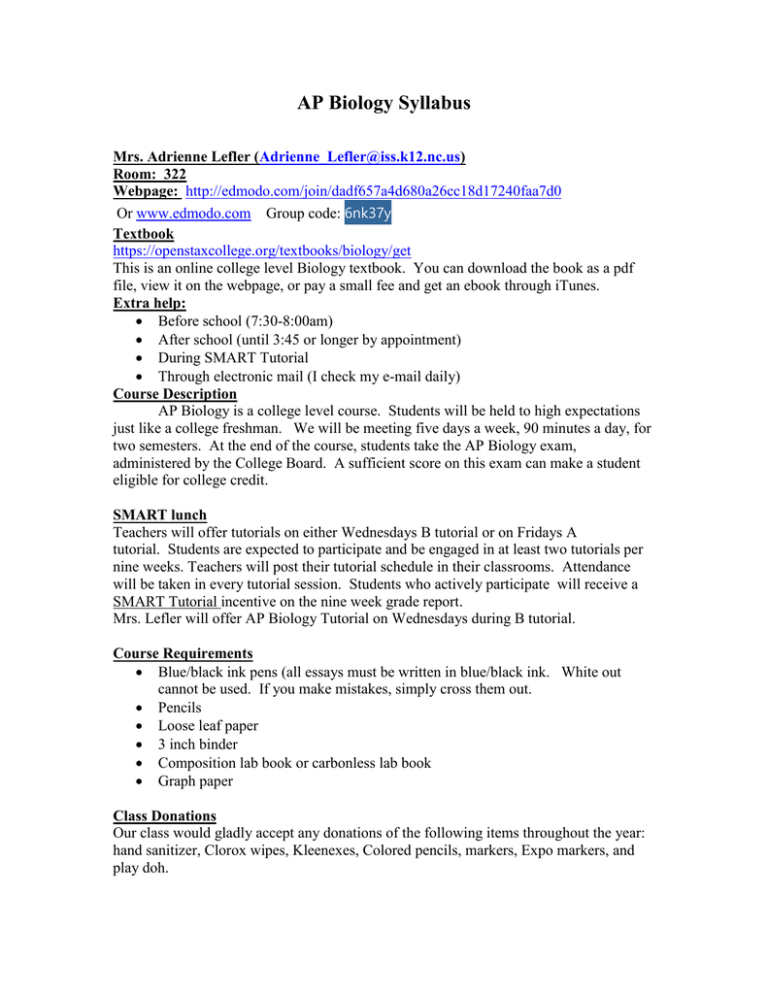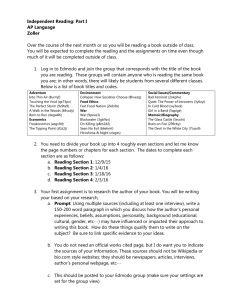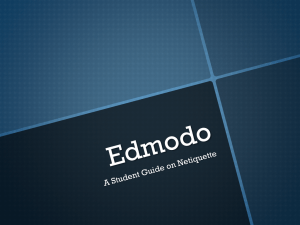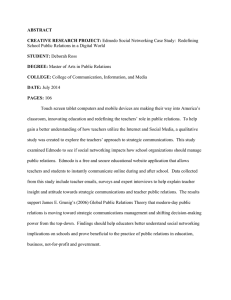AP Biology Syllabus
advertisement

AP Biology Syllabus Mrs. Adrienne Lefler (Adrienne_Lefler@iss.k12.nc.us) Room: 322 Webpage: http://edmodo.com/join/dadf657a4d680a26cc18d17240faa7d0 Or www.edmodo.com Group code: 6nk37y Textbook https://openstaxcollege.org/textbooks/biology/get This is an online college level Biology textbook. You can download the book as a pdf file, view it on the webpage, or pay a small fee and get an ebook through iTunes. Extra help: Before school (7:30-8:00am) After school (until 3:45 or longer by appointment) During SMART Tutorial Through electronic mail (I check my e-mail daily) Course Description AP Biology is a college level course. Students will be held to high expectations just like a college freshman. We will be meeting five days a week, 90 minutes a day, for two semesters. At the end of the course, students take the AP Biology exam, administered by the College Board. A sufficient score on this exam can make a student eligible for college credit. SMART lunch Teachers will offer tutorials on either Wednesdays B tutorial or on Fridays A tutorial. Students are expected to participate and be engaged in at least two tutorials per nine weeks. Teachers will post their tutorial schedule in their classrooms. Attendance will be taken in every tutorial session. Students who actively participate will receive a SMART Tutorial incentive on the nine week grade report. Mrs. Lefler will offer AP Biology Tutorial on Wednesdays during B tutorial. Course Requirements Blue/black ink pens (all essays must be written in blue/black ink. White out cannot be used. If you make mistakes, simply cross them out. Pencils Loose leaf paper 3 inch binder Composition lab book or carbonless lab book Graph paper Class Donations Our class would gladly accept any donations of the following items throughout the year: hand sanitizer, Clorox wipes, Kleenexes, Colored pencils, markers, Expo markers, and play doh. Course Rules My rules are congruent with school rules. Fundamentally they boil down to: 1. Respect everyone and everything in this school 2. You are here to learn. Effort is required 3. You are expected to do your own work. 4. You may not interfere with anyone else’s right to follow Rules 1, 2, and 3. Specific school policies about cell phones, mp3 players, food, hats, etc are enforced in this class. Course Expectations All AP students are expected to: Be on time Be ready to begin class when the bell rings Be prepared for class Participate freely Ask questions when confused Answer questions when asked Do all required work without complaint Work to curtail any disruption Generally act as the most mature incarnation of yourself Daily check of email/classroom website. (If you do not have internet access at home, you need to find a reliable buddy who will call you and let you know of any information I may have sent out or posted). Attendance o Your attendance in class is expected. You should understand that we will be moving at a very fast pace and any day you are absent will cause you to get behind. You are also responsible for getting any missed notes or work from a classmate. Notes o Prezis will be posted on Edmodo before class. You are expected to come into class with either notes already written or printed off. Readings o You are expected to follow along with the course planner and readings. There will be daily quizzes that cover material we have talked about in class, material in the readings, and vocabulary from the readings. Grading Policy Examinations: 50% Quizzes: 20% Classwork/Homework: 10% Labs: 20% Grades will be posted into Powerschool on most Fridays. Quizzes There will be quizzes practically every day. They will consist of anything from multiple choice questions, grid-in math questions, short free response questions, or long free response questions. Absences on quiz days will need to be made up as soon as possible and a plan should be made as to when the quiz will be up on the day of return. Labs You are required to complete every lab that we conduct. All labs will be written in a lab notebook. Lab notebooks will be turned periodically for a grade. Some (not all) labs will require a formal lab write up. Other labs will require a poster/presentation. We will go over what is required in your lab notebook before your first lab. Labs will remain set up a maximum of 5 days. If you miss a lab, you must make arrangements to make up that lab while the lab is still set up. Failure to do so will result in a lower lab grade. Exams Exams are given approximately 3 times a quarter and will be announced well in advance. They will consist of 30 multiple choice questions, 3 grid in questions, 3 single part free response questions and 1 multi part free response question; mirroring the AP exam. You will have 90 minutes to take each exam. Forty minutes for the multiple choice/grid in section, five minutes to read, and then four minutes to write responses to the free response questions. Students who are absent on exam days are expected to have a plan in place to make up their exam the day they return and their exam should be made up within a week of return. Failure to do so will result in a lower grade. Midterm Your midterm is required and is one fourth of your first semester average. It is a simulated AP exam. Nature Scrapbook All students will be required to complete a nature scrapbook. This scrapbook will be due May 26th. Students are to find an example of each of the following organisms and photograph it in its natural habitat. Students must take their OWN photographs. No swapping of shots or taking them from a book or the internet; include a time and date stamp on the picture if possible. If you are unable to include a time and date stamp, the best way to prove this is to place an item in all of your photographs that you might usually have on you like a key, pen, finger or your phone. You will then either use Power Point, Prezi, or develop a physical scrapbook to assemble a natural history collection of the specimens you “collect”. The collection will include a photo of the organism, its common and scientific names, an interesting fact about the organism and a statement describing where it was collected. Your scrapbook must include 10 insects (3 could be arachnids instead) 10 plants, 10 mammals, 10 fish, 10 herptiles (frogs, salamanders, toads, turtles, snakes, lizards), 10 trees, 10 birds. Biology Survivor After the AP Exam, we will complete a series of Survivor like challenges. More information about this will be given to you after the AP Exam. Final Exam/Project The Final Exam/Project will be discussed after the AP Test. It will count as 20% of your final grade for the Spring Semester. Late Work Policy Work is considered “late” when it is submitted after the established collection time. Late homework and classwork can earn a maximum of half credit. Projects and labs lose 10% of total credit for every day that they are late. Makeup work: It is strongly recommended that you attend class every day in a timely fashion. Excessive lateness or absences will make it very difficult for you to keep up with the workload of this course. If you are legally absent, it is your responsibility to makeup all assignments. “I was absent” is not an excuse for missing an assignment (unless I excuse you). All assignments are posted on the class calendar, which is accessible from all course websites. Please discuss missed work with me as soon as you return to class. Work done during absences is due one day after your return to class. You must also make arrangements to makeup any labs, quizzes, or tests as soon as you return to school. Class Communication Class communication will occur through Edmodo. Students are expected to join Edmodo before the end of the first week. Class information, prezis and other documents will be posted on Edmodo. Parents may join Edmodo and receive the same information through their student’s account. How to Sign Up as a Parent: 1. Obtain the unique 6-digit Parent Code from your child’s account (this is not the same as your child’s Group Codes). The Parent Code is attached to your child’s account. You can get this the following ways: Your child’s Edmodo Homepage: the Parent Code is located on the bottom of the left side panel. Your child’s teacher can provide you with the Parent Code. 2. After you have the parent code, go to www.edmodo.com (currently, you cannot create your Account on the mobile or iPad Edmodo app). 3. Click “I'm a Parent” and fill in the necessary information and Parent Code. Note: Each child has a different Parent Code. You do not have to share a Parent Account with another parent, relative, or guardian. Multiple Parent Accounts can be set up for one student. Simply use the same Parent Code found on the student’s account to create a second Parent Account (must have a different email address). Academic Honesty You are allowed to collaborate on lab exercises. Data among lab partners is expected to be identical. With this exception, all work done in class is expected to be original or attributed to its original source in either MLA or APA format. Any violation of this will result in an automatic 0 on the assignment in question. Cheating on exams will result in an automatic 0, mandatory change of seating, academic referral and notification of parents, notification of guidance counselor, notification of grade-level administrator and the inability to ever receive a college recommendation from me for all parties involved. Additional Help I am available every morning from 7:30 until 8:00am. I am also available afternoons by appointment, during SMART tutorial time, and through email and Edmodo. I encourage students to form their own study groups to assist them through difficult material. I also encourage students to watch Paul Anderson’s Bozeman Biology videos on YouTube. They are great sources of additional information. The AP Exam The AP exam will be given May 11th. It is administered by the College Board and is given in a secure room. There is a fee for taking the exam. All students who are in this course are required to sit for the AP exam. The grade received on the AP exam does not affect a student’s grade for the course in any way. Class Tee Shirt Toward the end of the semester we will accept designs for a class tee shirt. We will vote on the tee shirt and take orders. We will try to have the tee shirts in before AP Biology Survivor week so that we may wear the shirts for some of the challenges. On-line behavior All interaction in the on-line environment must be conducted within the guidelines of the districts Acceptable Use Policy, which you have signed prior to this year. Parents/Guardians: Please sign, detach, and return this portion of the syllabus verifying that you have read and understand all of the rules and procedures. You may also email Mrs. Lefler at Adrienne_Lefler@iss.k12.nc.us. Parent signature Student name Course Sequence: Unit: Topics: Introduction/Biochemistry Time frame: 2 weeks Nature of Science Water Organic Compounds Enduring Understandings/Essential Knowledge Addressed 1D2, 2A1, 2A2, 2A3, 2C1, 2D1, 3A1, 4A1, 4B1, 4C1 Activities: Hillis Readings Starr-Tagg Readings Campbell Readings Cricket lab (graphing and statistical analysis) 2-14 17-32 35-45 4-15 22-31 36-50 289-313 316-331 333-345 348-364 272-289 294-301 306-322 328-340 3-24 30-42 46-54 58-66 68-89 452-465 468-484 487-504 507-530 57-76 79-98 125-142 56-76 82-93 150-160 164-172 94-122 125-138 206-224 228-242 46-54 101-120 98-110 114-128 132-146 142-159 162-181 185-202 Gumdrop reactions Evolution Time frame: 3 weeks Cell Biology/Cell Division Time frame: 6 weeks Darwin’s Theory Genetic Drift Evidence of Evolution Speciation History of life Organelles Cell Membranes Passive Transport Active Transport Cell Communication Cell Cycle 1A1, 1A2,1A3, 1A4, 1B1, 1C1, 1C2, 1C3, 1D1, 1D2, 3A1, 3A2, 3A3, 3C1, 3C2, 4A6, 4B3, 4C3, 4C4 1B1, 1D2, 2A1, 2A1, 2A2, 2A3, 2B1, 2B2, 2B3, 2C1, 2C2, 2D1, 2E1, 3A1, 3B1, 3B2, 3D1, 3D2, 3D3, 3D4, 4A2, 4B2, 4C1 Artificial selection lab and report Mathematical modeling lab* Darwin Finches and Natural Selection Case Study Facebook organelle pages Little Mito Case Study Membrane Models Diffusion and Osmosis open Inquiry lab and lab report Campus Coffee shop case study Mitosis and Cancer lab Metabolism Time frame: 4 weeks Energy Enzymes Cell Respiration Photosynthesis 1B1, 1D2, 2A1, 2A2, 2A3, 2C1, 2C2, 2D1, 2D3, 2E1, 3B2, 4A1, 4A2, 4A4, 4B1, 4B2, 4C1 Meiosis lab Toothpickase Enzyme catalysis open inquiry and lab report Cell Respiration lab and poster/presentation Photosynthesis lab and poster/presentation Genetics Time frame: 4 weeks Mendel Linked Genes Genetic Disorders 1A1, 1A3, 1A4, 1C1, 1C3, 2D1, 3A2, 3A3, 3A4, 3B1, 3B2, 3C1, 3C2, 4B2, 4C1, 4C2 Case Studies: Diet to Die For Mystery of Seven Deaths Drug Target Virtual Fly lab and poster/presentation 145-164 176-190 196-212 248-260 262-279 286-301 166-185 188-206 209-223 227-262 216-224 228-235 238-249 254-263 305-320 325-347 351-377 396-422 426-445 367-386 389-406 409-432 438-452 457-501 348-360 366-381 386-400 406-412 416-440 381-393 536-553 556-572 575-597 600-615 M&M Chi Square activity and poster/presentation Case Studies: Not Exactly More than Meets the Eye Those Old Kentucky Blues Living with Her Genes PKU Carriers Moleculer Heredity Time frame: 4 weeks Biodiversity/Classification Time Frame: 2 weeks History of DNA Replication Transcription/Transla tion Mutations Viruses Bacteria Eukaryotic Gene Expression Biodiversity Classification Scheme Cladograms 1B1, 1C1, 1C3, 2C1, 2D1, 2E1, 3A1, 3B1, 3B2, 3C1, 3C2, 3C3, 4A1, 4A2, 4A3, 4A4,, 4B1, 4C1, 4C2 Replication Activity Transcription/Translation Activity DNA Scissors and Paper Plasmids Bacterial Transformation lab and lab report 1B2, 2A2, 2C2, 2D1, 2D2, 4A4 Restriction Enzyme lab and poster/presentation Animal Evolution and Body Plans Cytochrome C lab Comparing DNA sequences with BLAST and poster/presentation Organismal Physiology Time Frame: 4 weeks Nutrition Transport Regulation 1B1, 1C3, 1D2, 2A1, 2A2, 2A3, 2C1, 2C2, 2D1, 2D2, 2D3, 2D4, 2E2, 3B2, 3C2, 3D1, 3D2, 3D3, 3D4, 3E1, 3E2, 4A3, 4A4, 4B1, 4B2, 4C1 Thermo/Osmoregulat ion Physiology of Circulatory System Lab and report Transpiration lab and report Hormonal Control Nervous Sensation, Integration, Response Reproduction Ecology Time Frame: 3 weeks Development Behavior Population Dynamics Community Interactions Ecosystem Conservation Biology 1C1, 1C3, 2A1, 2A2, 2A3, 2C1, 2C2, 2D1, 2D3, 2D4, 2E3, 3E1, 4A5, 4A6, 4B3, 4B4, 4C3, 4C4 618-633 636-651 654-664 785-97;875895 764-782; 898 -925 522-528;765780 529-536;729762 785-796 524-532;726740 666-682;708720 490-501 589-600 746-755 954-972 621-635 688-703 930-951 540-551, 604617 673-692 628-641 696-709 608-622;646661 538-546;760773;778-802 552-562 821-846; 975-994 1047-1059; 1064-1083 1087-1116 Evolution of Systems Project Case Studies: Andrea: Death of a Diabetic Immunological Malfunction Left Out In The Cold It Takes A Lot of Nerve Immunity 446-271 478-484 Pill bug open inquiry lab and poster/presentations Energy Dynamics lab and report Modeling Population Growth Wooly Worm Lab Case Studies: A Deadly Passion Coyote Removal Fish Kill Mystery Threats to Biodiversity 556-570;638653 264-283;551554;656-669 800-817 823-839 843-856 860-870 873-888 893-907 580-602 808-823 828-841 846-862 868-884 890-912 918-931 801-817; 997-1018 736-760; 1021-1041 1120-1142 1148-1167 1174-1193 1198-1218 1222-1234 1245-1265


